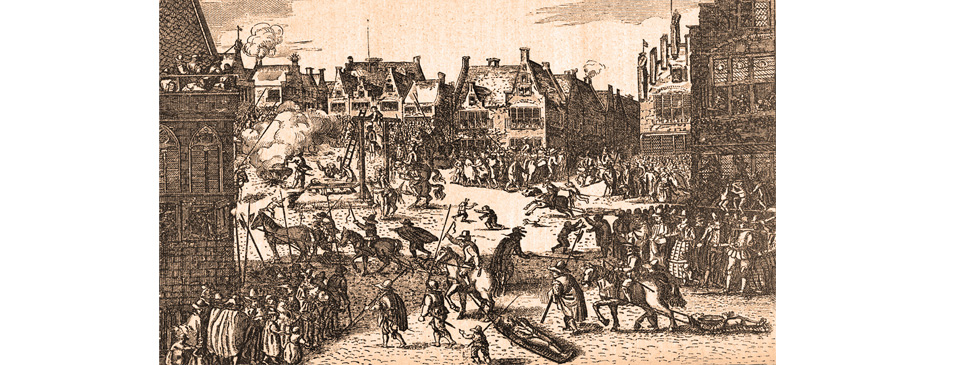The Gunpowder Plot

The execution of the Gunpowder Plot conspirators as imagined by the Dutch printmaker Claes Jansz Visscher c.1606
With the forewarning of the letter, the following day the Lord Chamberlain searched the Parliament buildings and found Fawkes in the cellar but not the gunpowder and this was reported to the King. A second search was undertaken by Sir Thomas Knyvett and a little before midnight on the 4th the gunpowder was discovered and Fawkes arrested.
In the early hours of the morning Fawkes was taken under guard to the King’s bedchamber at Whitehall Palace where the Privy Council were meeting. He initially continued to maintain that he was Percy’s servant. Asked by the King how he could carry out such treason, Fawkes answered that such a desperate disease required a desperate remedy and that he intended to blow the King, a Scotsman, back into Scotland.
By the 5th, news of Fawkes’ capture reached the others and most fled London to Warwickshire. On the 8th, however, they were arrested by the Sheriff of Worcester and a posse of men, during which Catesby, the Wrights and Thomas Percy were fatally wounded. Francis Tresham was apprehended in London and imprisoned in the Tower. Under gradual and increasing torture, authorised by the King, Fawkes confessed to the plot and the names of the conspirators. At the end of November Thomas Wintour also confessed and it is through his and Fawkes’s accounts that we today know of the details of the plot.
During December it was said that Tresham had died in the Tower of London, possibly through illness, but others think he was secretly set free. The Government began to round up Jesuit priests who they believed were behind the plot. Father Henry Garnet, the Superior of the English Jesuits, and two others were arrested in January 1606.
The trial of the conspirators began in Westminster Hall on the same day as the capture of Garnet. None of them denied the charge of treason and all were sentenced to death. Four were hanged, drawn and quartered in St. Paul’s Churchyard on 30th January. The following day Wintour, Fawkes and two others died the same way in Old Palace Yard at Westminster. Fawkes was so frail from torture that he needed to be helped up the ladder to the scaffold from where he gave a speech urging Catholics not to resort to such measures in the future. The three who had died in the fight in Warwickshire were exhumed and their heads removed to be displayed on spikes.
In March Henry Garnet was tortured on the rack and gave a full confession. He had earlier been given some hints of the plot directly from Catesby. Subsequently he heard via the priest Oswald Tesimond, to whom Catesby had revealed the information under seal of confession, passed from Tesimond to Garnet under the same conditions. Catesby had given permission for the information to be revealed in the event of torture and thus Garnet was free to give the confession. Tesimond escaped but, despite of his confession, Garnet was executed in May. As he was being hanged, people in the crowd pulled at his legs so he could die quickly and thus not endure the pain of being disembowelled alive.
As with earlier plots against Queen Elizabeth, the actions of the conspirators had the opposite to their intended effect, creating further anti-Catholic sentiment in the country and widespread belief that all papists were traitors. In January 1606 severe anti-Catholic legislation was passed that satisfied the majority, yet the laws were never rigorously enforced.
In more recent times doubts and conspiracy theories have grown and questions asked about the incident. Who really sent the letter to Lord Monteagle that exposed the plan? What was the actual fate of Francis Tresham? What were the intentions of the plotters should their scheme have been successful? Could Robert Cecil and other ministers have been secretly behind the conspiracy in order to implicate and eradicate Catholic and other opposition?
In support of this latter theory, Cecil had already made clear his concerns about the Catholic sympathiser Henry Percy, Earl of Northumberland. Following the uncovering of Percy’s brother as one of the plotters, Northumberland was arrested and imprisoned in the Tower for seventeen years, despite evidence that showed he had intended to be alongside the King in Parliament at the time of the assassination. There is little evidence to support the theory about Cecil’s scheming but it remains within the realms of possibility given the politics and public attitudes of the times.
Sources include: Barry Coward ‘The Stuart Age’; Philip Caraman ‘Henry Garnet 1555-1606 and the Gunpowder Plot’. Many thanks to Olwen Maynard for addition information.
< Back to Early Stuart London


